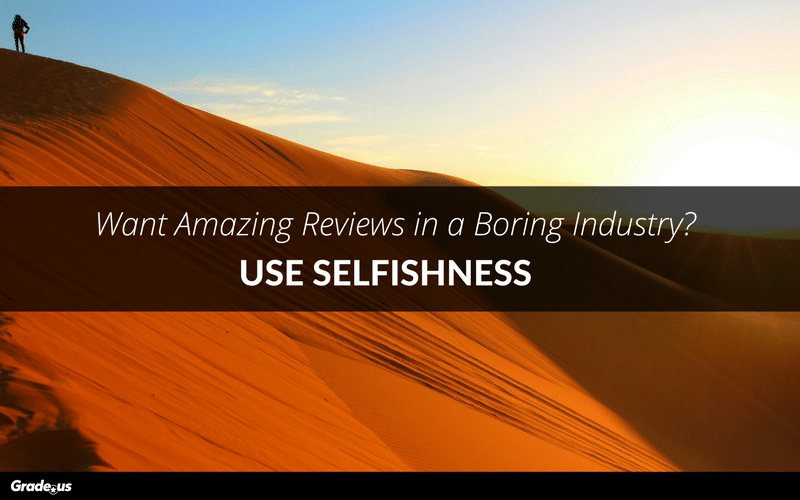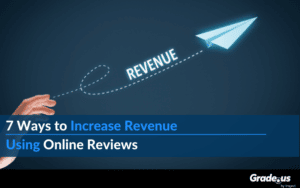Your product is boring…
… If you’re selling insurance. Running a manufacturing business, shipping container company or software development firm? Your product is boring too. If your product is boring you already know it.
But it’s not just the product that’s boring, it’s your industry. Bring up insurance with customers and watch as they quickly become overwhelmed, glaze over and tune out.
That’s a problem, isn’t it?
You want to get more customers and stand out from your competitors. You’re eager to share glowing reviews from happy customers with prospects.
Only customers aren’t all that eager to share.
It’s frustrating, isn’t it? Customers are drawn to great reviews, but those same customers hesitate when it’s time to share their reviews. They’re not exactly chomping at the bit to review a product or service they find boring or uninteresting.
You know the value of a great review. Your customers know the value of a great review. How do you get them to share? It’s not like you can make a boring topic like shipping or manufacturing exciting.
Or can you?
Selfishness makes boring industries exciting
Did he just say selfishness was okay? Absolutely, here’s why. As it turns out, selfishness has two faces.
When we think of selfishness, we think of the predatory kind. The kind that motivates bullies to lie, cheat and steal to get what they want. The kind that motivates the greedy to steamroll other people to be first in line.
This kind of selfishness is, as you know, gross and unethical.
Then there’s the other kind of selfishness. The kind customers display when they come to you for help. When customers come to you for help they’re completely focused on… you?
Hah, No.
They’re focused on two things “I and me.”
- How can you help me?
- Have you helped other customers like me?
- Can you give me a discount?
- Why should I trust you?
If you’re an experienced pro you’ve seen this kind of selfishness. Customers are selfish because they have to be. I call it survival selfishness.
A wrong move could be financially devastating, career ending or deeply humiliating.
- Robert Kiyosaki chose the wrong manufacturing firm for his Velcro wallet business. They stole his designs, quickly churning out low priced knockoffs. He was bankrupt within a few months.
- Peter Drier, purchased health insurance to cover his neck surgery. He verified he was covered before his surgery, but his insurance company left him with a $117,000 dollar bill.
Consequences can be painful and severe. Selfishness shields customers from a potential disaster.
Selfishness is key to amazing customer reviews
Reviews relieve customer fears, boosting their confidence and trust in you. How?
Make customer selfishness work for you.
Customers are unique. Each one comes to you with a specific trigger that drives them. Used well, these triggers dramatically increase your odds of success.
Want an amazing, standout review in your industry? Lead with these triggers. Here’s how.
Step 1: Identify your customer’s emotional triggers
As people, we’re motivated primarily by emotion (though others refuse to admit it). You’ll want to track the information your customers give you. Helpful information comes from any touch point or information source customers have with you. For example…
- If you’re an insurance company, this could be a bad experience a customer had with your competitor.
- If you’re a manufacturing company, this could be a tech startup client with a long list of awards and accolades.
- If you’re a software or app developer, your customer could be worried about their project being completed on time and in budget (which is rare).
You’ll want to catalog the list of common emotions and problems surrounding your product or service. Each problem comes with an emotion; customers being cheated, service not delivered as promised, horrible customer service, etc. Negative emotions like fear, distrust, contempt, frustration and anger are gold mines.
A two question survey asking customers (a) how they found you and (b) why they chose you is a great way to flush out these emotional triggers.
Step 2: Flesh out your customer’s emotional triggers
The best way to identify the cause of your customer’s emotional distress is to ask. But you’ll need to know what to ask and how to ask it ahead of time.
Get it wrong and it’s possible you’ll lose, alienate or anger your customer unnecessarily.
Sounds a bit vague, right?
Here’s a short list of the things you’re looking to accomplish with your questions.
- No humiliation. Your questions shouldn’t humiliate, shame or embarrass your customer. If it even smells condescending try again.
- Give them an out. When your questions touch negative or sensitive points it often brings up painful memories. Give customers a way to skip, shorten or avoid the painful parts.
- Respect their privacy. Some questions are off limits. Money (gains or losses), intellectual property, or volatile circumstances should be handled with privacy and care.
Create questions that delve into your customer’s negative emotions. Verify that your questions protect and honor their dignity.
You’ll want to customize the questions for your business and circumstance. If possible, look for ways to personalize the questions for each customer.
You can store these details in your CRM or customer database tool of choice.
Step 3: Pitch using these emotional triggers
Okay. We’ve identified the circumstances and events that motivated your customers to work with you. We’ve also identified the emotions behind those triggers. Now it’s time to put those details to work.
You’re ready to ask for the review.
Take the details you’ve discovered for your customers and tailor your request accordingly, like this:
Hi Jan,
I remember you mentioning something about a horrible customer service experience with [competitor].
We’re trying to make our service better. Would you be willing to share your story?
Yay or Nay?
Andrew
See what I did there?
I used the emotional triggers I collected ahead of time to grab Jan’s attention. Then I gave her the chance to fix the problem, at least with us.
I used a friendly “Yay or Nay” to ask for a commitment, and my first name to communicate our low pressure pitch.
This worked in our industry but it may not work in yours so it’s a good idea to customize your pitch. You’ll want to tailor things for your industry, product and customer.
The more personal your approach the greater your odds of success.
If customers expect you to be personable, do it. If they’re looking for professionalism, meet them where they’re at. Do what you can to put your customers at ease. They’re doing you a favor after all.
Are your customers…
- Focused on prestige? Mentioning they’re one of your top 10 customers can meet their need for recognition and affirmation.
- Reeling from a bad experience? Dive into their horrible experience with them, then make a gesture of good will to show you care.
- Anxious and distrustful? Show them your appreciation; let them know you know they don’t trust easily.
Customers are selfish because they have to be. Often times, there’s a story behind their selfishness. That selfishness is your opportunity.
Step 4: Interview your customers
Interviewing customers gives them a chance to share their war stories. This gives you the natural opening you need to segue into your review questions.
Get permission to record the interview, letting customers know you won’t use it publicly without their permission (this is key).
When you’re finished, transcribe the interview and send it to your customers asking if they’d be willing to share (copy and paste) their review on the site you need them to, like this:
Hey Jan!
You’re amazing.
Your feedback was absolute gold, thanks so much for taking the time to share your story. Would you be willing to share it as a review on Google Places?
Here’s the link: www.link.com
Just copy and paste your feedback, then click Post.
Thanks in advance,
Andrew
Turbo charge your results by posting the audio or video of their feedback on your site directly, reinforcing the review your customer has just posted for you!
When you’re done, do something nice to show your gratitude and validate their decision to post their review. Just be sure to do it after they’ve posted their review.
Step 5: Spread the word
It’s great if customers find your ad on their own, but wouldn’t it be something if they saw it whenever they were in the market for your product or service?
That would be incredible right? Here’s how you make that happen.
You advertise it. Many companies neglect to advertise their boring product or service and it’s incredibly rare to find companies advertising their reviews.
Use your reviews proactively.
When reviews are added into your advertising mix the results are exceptional. Here’s a few ideas you can use to get things started.
- Facebook Carousel Ads. You can put together a small sample of reviews for your product or service.
- Retargeting campaigns. Show amazing reviews to prospects who’ve seen your ad, visited your website or downloaded your lead magnets.
- On thank you pages. You can post your amazing reviews on your lead magnet thank you pages. A customer downloads a helpful piece of content from you, you show them your happy customers, inviting them to become one.
- Search + Display. If you’re running pay-per-click campaigns on Facebook, Google or Bing, you can boost brand recognition in a non-sleazy way. Run display ads on sites visited by your target audience to supplement searcher queries.
Combining these ideas has an amazing compounding effect on your business. Instead of passively waiting for customers to find these positive reviews, you’re using them to start a conversation, with increased trust from the very beginning.
Your industry may be boring but thanks to a proactive approach, your product is suddenly fascinating. Prospective customers begin seeing themselves in your customer reviews. These reviews begin building trust and defusing objections, slowly melting away the fear, tension and risk prospects feel.
Reviews aren’t really a thing here
Some people view reviews as an online thing, that it’s only effective in the online or retail world. “We rely on word-of-mouth and referrals” they claim.
Here’s the problem.
Reviews and word-of-mouth are basically the same thing! The only thing that’s different is the communication medium. When it’s online it’s done via video, audio or text. When it’s offline it’s done via the phone or person-to-person interaction. But the purpose is the same. To transfer enthusiasm and trust from one person to another.
So, change the medium if necessary. Make these strategies work for you. Do whatever it takes to put customers at ease
Boring makes selling an uphill battle
Your industry may be boring, but you don’t have to be. Tell your customer’s story. Use their reviews to stand out. Then share the good news with everyone in your target audience.
You want to get more customers – and you will, if you get customers to vouch for you.
Customers are drawn to great reviews, but those same customers hesitate when it’s time to share their story. Make the story theirs, and they’ll be chomping at the bit to share.
Fascination guaranteed.
About the Author
Andrew McDermott
Andrew McDermott is the co-founder of HooktoWin. He shows entrepreneurs how to attract and win new customers.










